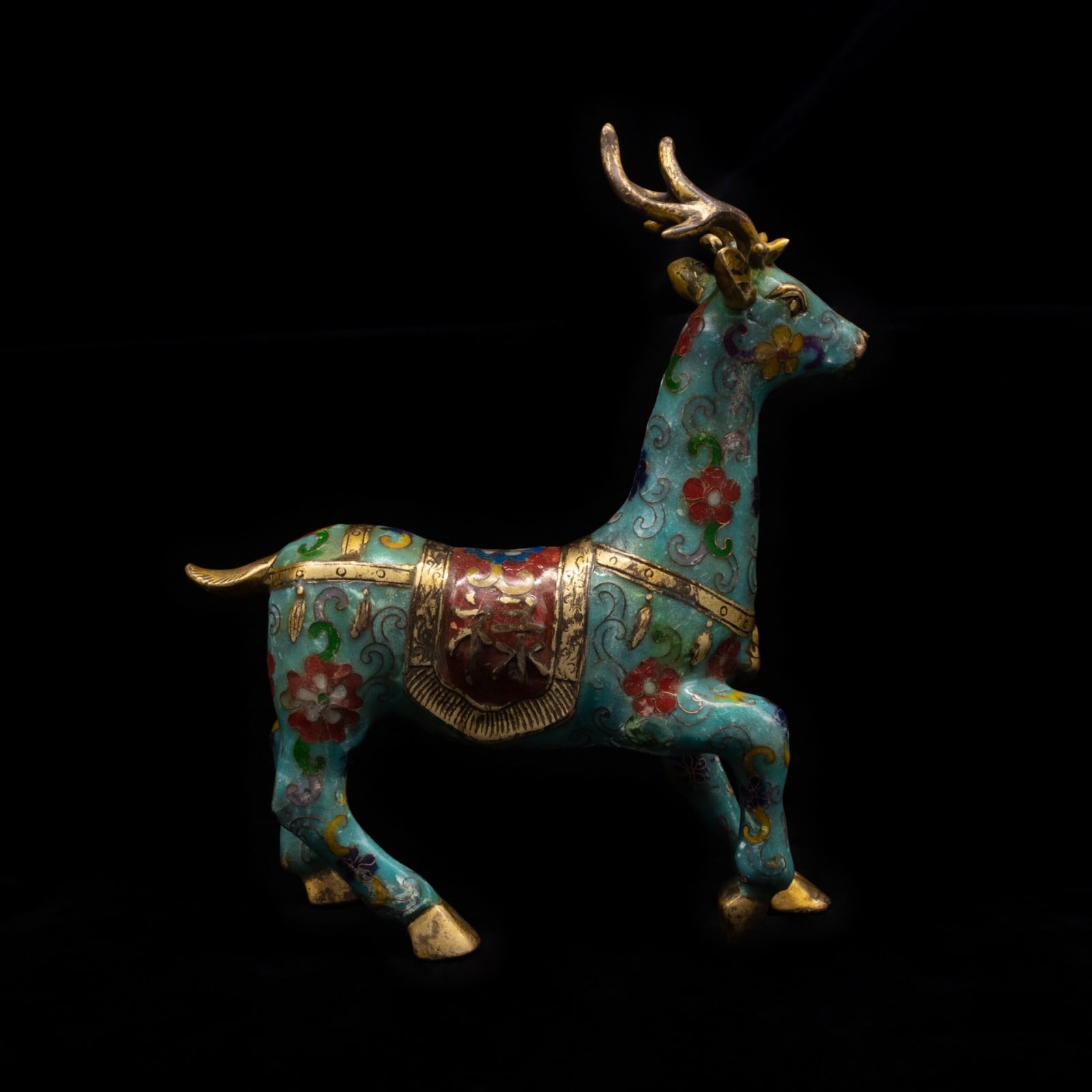Qing Cloisonné Sika Deer, Nineteenth Century AD
Enamel, Gold, Gilt Bronze
22 x 5.4 x 19.5 cm
8 5/8 x 2 1/8 x 7 5/8 in
8 5/8 x 2 1/8 x 7 5/8 in
ES.3879
Further images
In Chinese, the word for ‘deer’ (lù) sounds an awful lot like a word for prosperity (also lù), which itself became a term for the emoluments received by Chinese officials....
In Chinese, the word for ‘deer’ (lù) sounds an awful lot like a word for prosperity (also lù), which itself became a term for the emoluments received by Chinese officials. Deer, then, are seen as especially auspicious symbols in Chinese art. The ‘hundred deer’ (bǎi lù) motif, which appeared in painting and pottery, represented a wish for promotion through the Chinese bureaucracy as well as a general desire for prosperity. They were often accompanied in Chinese art by pines, which represent longevity, and therefore express the hope that prosperity and advancement might be long-lasting. Deer were also appreciated for their aesthetic value, and they were a feature of the great Imperial Parks which dotted China for the pleasure of the Emperor and his court.
This figure is exquisitely modelled, depicting a male sika deer (Cervus nippon) in full gallop. His head is erect and alert, his legs outstretched, his body taught, and his tail raised. He wears a bell around his neck, strapwork picked out in gilding, and a cloth over his back. His body is decorated with a series of floral decorations, set on a field of foliate tendrils, executed in high-quality cloisonné enamel. Cloisonné is a process whereby a pattern is marked out using threads of gold or silver onto the surface of the figure, creating compartments (cloisons in French). Then, a paste of coloured enamel is worked into the compartments and fired, often in several stages, to leave a brightly-coloured final product. The technique is ancient, having been invented by the Egyptians (using cut gemstones rather than enamel paste), but only arrived in China in the Fourteenth Century AD.
Nature (zirán) is a key concept in Chinese art, but the nature that is represented is bounded. The form of the deer is contrasted with the artificiality of the decoration, ensuring that this piece only retains a tenuous connection to the world outside of human habitation and control. For the Chinese, nature was a self-generating, complex arrangement of elements which are continuously changing and interacting. Man is a crucial component of the natural world, and Chinese philosophy speaks of the need to bend to nature’s rhythms. This piece, therefore, not only represents the bounded Chinese view of nature, but also the harmony between the natural and the man-made.
This figure is exquisitely modelled, depicting a male sika deer (Cervus nippon) in full gallop. His head is erect and alert, his legs outstretched, his body taught, and his tail raised. He wears a bell around his neck, strapwork picked out in gilding, and a cloth over his back. His body is decorated with a series of floral decorations, set on a field of foliate tendrils, executed in high-quality cloisonné enamel. Cloisonné is a process whereby a pattern is marked out using threads of gold or silver onto the surface of the figure, creating compartments (cloisons in French). Then, a paste of coloured enamel is worked into the compartments and fired, often in several stages, to leave a brightly-coloured final product. The technique is ancient, having been invented by the Egyptians (using cut gemstones rather than enamel paste), but only arrived in China in the Fourteenth Century AD.
Nature (zirán) is a key concept in Chinese art, but the nature that is represented is bounded. The form of the deer is contrasted with the artificiality of the decoration, ensuring that this piece only retains a tenuous connection to the world outside of human habitation and control. For the Chinese, nature was a self-generating, complex arrangement of elements which are continuously changing and interacting. Man is a crucial component of the natural world, and Chinese philosophy speaks of the need to bend to nature’s rhythms. This piece, therefore, not only represents the bounded Chinese view of nature, but also the harmony between the natural and the man-made.













